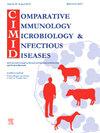伯纳蒂克希菌的全球流行病学和分子分型:人类和动物Q热的系统综述
IF 2
3区 农林科学
Q4 IMMUNOLOGY
Comparative Immunology Microbiology and Infectious Diseases
Pub Date : 2025-08-28
DOI:10.1016/j.cimid.2025.102401
引用次数: 0
摘要
根据PRISMA指南进行的这一系统综述,全面综合了全世界人类和动物中Q热病原体伯纳蒂克希菌的流行病学数据。共确定1321份出版物,其中166份符合纳入标准。Q热于1937年首次在澳大利亚屠宰场工人中被描述,目前仍是一种全球分布的人畜共患病,家养反刍动物(绵羊、山羊、牛)是人类感染的主要宿主和来源。传播主要通过吸入被污染的气溶胶发生,特别是在分娩或流产事件期间。病原体是一种严格意义上的胞内细菌,具有小基因组(~ 2 Mb)和质粒多样性,有助于菌株变异。实验室诊断主要依靠血清学(IFA为金标准)和PCR进行早期检测,而由于生物安全问题,培养仅限于BSL-3设施。分子流行病学随着多间隔序列分型(MST)、多位点可变数串联重复序列分析(MLVA)和全基因组测序(WGS)等分型方法的发展取得了进展。尽管MLVA和WGS具有更高的鉴别能力,但MST因其可重复性和适用于临床和环境样本而被广泛使用。基因分型显示了显著的宿主和区域特异性多样性,一些谱系,如法属圭亚那的MST17,与严重疾病有关。在地理上,Q热表现出明显的异质性。在欧洲,零星病例与大规模暴发并存,荷兰疫情(2007-2010年)就是一个例子,其中4000例确诊人间病例与山羊养殖场有关。法国、德国、西班牙和意大利也报告了地方性流行,通常具有区域不同的基因型。在非洲,流行率差别很大,尽管监测有限,但埃及的流行率高达32% %,阿尔及利亚骆驼的流行率高达 70% %。北美、拉丁美洲、亚洲和澳大利亚也有记录,诊断不足在欧洲以外很常见。总体而言,该研究强调Q热是一种持续存在的全球人畜共患病,其负担被低估,需要加强监测、分子流行病学和“同一个健康”方法,以减轻对人类和动物健康的影响。本文章由计算机程序翻译,如有差异,请以英文原文为准。
Global epidemiology and molecular typing of Coxiella burnetii: A systematic review of Q fever in humans and animals
This systematic review, conducted according to PRISMA guidelines, provides a comprehensive synthesis of epidemiological data on Coxiella burnetii, the causative agent of Q fever, in humans and animals worldwide. A total of 1321 publications were identified, of which 166 met the inclusion criteria. Q fever, first described in 1937 in Australian abattoir workers, remains a globally distributed zoonosis, with domestic ruminants (sheep, goats, cattle) serving as the primary reservoirs and sources of human infection. Transmission occurs mainly via inhalation of contaminated aerosols, particularly during parturition or abortion events. The pathogen is a strict intracellular bacterium with a small genome (∼2 Mb) and plasmid diversity that contributes to strain variation. Laboratory diagnosis relies primarily on serology (IFA as gold standard) and PCR for early detection, while cultivation is restricted to BSL-3 facilities due to biosafety concerns. Molecular epidemiology has progressed with typing methods such as Multispacer Sequence Typing (MST), Multiple-Locus Variable number tandem repeat Analysis (MLVA), and Whole Genome Sequencing (WGS). MST is widely used due to its reproducibility and application to clinical and environmental samples, though MLVA and WGS provide higher discriminatory power. Genotyping has revealed significant host- and region-specific diversity, with some lineages, such as MST17 in French Guiana, associated with severe disease. Geographically, Q fever shows marked heterogeneity. In Europe, sporadic cases coexist with large outbreaks, exemplified by the Netherlands epidemic (2007–2010) with > 4000 confirmed human cases linked to goat farms. France, Germany, Spain, and Italy also report endemicity, often with regionally distinct genotypes. In Africa, prevalence varies widely, reaching up to 32 % in Egypt and > 70 % in camels in Algeria, though surveillance is limited. North America, Latin America, Asia, and Australia also document circulation, with underdiagnosis common outside Europe. Overall, the study highlights Q fever as a persistent global zoonosis with underestimated burden, requiring strengthened surveillance, molecular epidemiology, and One Health approaches to mitigate human and animal health impacts.
求助全文
通过发布文献求助,成功后即可免费获取论文全文。
去求助
来源期刊
CiteScore
4.60
自引率
0.00%
发文量
102
审稿时长
40 days
期刊介绍:
Comparative Immunology, Microbiology & Infectious Diseases aims to respond to the concept of "One Medicine" and to provide a venue for scientific exchange. Based on the concept of "Comparative Medicine" interdisciplinary cooperation between specialists in human and animal medicine is of mutual interest and benefit. Therefore, there is need to combine the respective interest of physicians, veterinarians and other health professionals for comparative studies relevant to either human or animal medicine .
The journal is open to subjects of common interest related to the immunology, immunopathology, microbiology, parasitology and epidemiology of human and animal infectious diseases, especially zoonotic infections, and animal models of human infectious diseases. The role of environmental factors in disease emergence is emphasized. CIMID is mainly focusing on applied veterinary and human medicine rather than on fundamental experimental research.

 求助内容:
求助内容: 应助结果提醒方式:
应助结果提醒方式:


